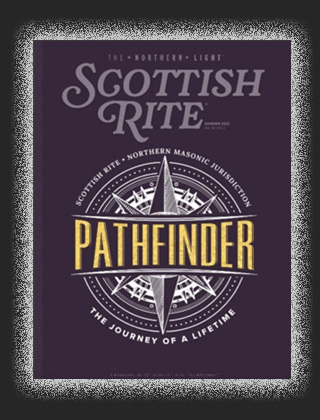The Scottish Rite Masonic Museum & Library holds nearly two dozen powder horns in its collection. Some are from the era of the American Revolutionary War and bear carvings that reflect that use; some feature carvings of Masonic symbols. This unusual double powder horn is particularly intriguing because it exhibits both types of carvings.
Powder horns, made from animal horn (often cow or oxen), were used by soldiers in the field to keep gunpowder dry and secure. The holes at the tips of the horns were used to pour powder into a paper cartridge or directly into the barrel of a musket. Many were carved with designs that were meaningful specifically to the owner. The words “John P. French His Horn” are carved into the surface, identifying the horn’s owner. On this fascinating object, French showcased his Masonic affiliation, his interest in slogans, and possibly his personal hobbies.
One of the slogans that appears on the horn is “Don’t Tread On Me” above a snake. This phrase was first used in South Carolina in 1775 by Christopher Gadsden, then-Lieutenant Governor of the state. It was inspired by Benjamin Franklin’s 1754 “Join or Die” political cartoon showing the colonies as pieces of a snake, indicating that union between the British colonies was necessary for survival. The slogan became well-known after it was used on naval flags during the Revolutionary War. Another phrase that adorns French’s horn is “Freedom and Victory.” While there is no one known usage of this slogan, the ideals align with the goals of the American Revolutionary War.
The majority of the carvings on this double powder horn are connected to Freemasonry, perhaps a sign that the fraternity and its teachings held special meaning to French. The slogan “Cemented with Love” appears, which refers to the tight bonds that Masons encourage and enjoy with their brethren. This phrase also appears on aprons, badges, certificates, and other items in the museum and library’s collections.
Along with this Masonic slogan, French applied around two dozen symbols from the teachings of Freemasonry to his horn. Some symbols are common to all forms of Freemasonry, such as a trowel, a gavel, a coffin, a beehive, and two pillars called Boaz and Jachin. One is a stone archway often represented in Royal Arch Freemasonry, the first four degrees of the York Rite. This arch is topped by a figure identified as “Hiram.” Hiram Abiff is a significant character in Freemasonry’s third degree.
In addition to symbols representing his political and Masonic interests, French also carved what appears to be a hunting scene, featuring a man holding a rifle, a dog, a mountain lion, a bird, and a deer. Perhaps these symbols reflect a pre-war activity.
Unfortunately, even with the helpful addition of a middle initial, the name “John French” was so common at the time of the Revolutionary War that we cannot establish the owner’s identity from military records. French appears to have been a member of the fraternity, but we cannot ascertain to which Masonic lodge he belonged. While we do not know where John P. French lived or very much about him, the symbols he chose to carve on his powder horn give us a sense of what he valued.
By Stacey Fraser, Assistant Curator, Scottish Rite Masonic Museum & Library




